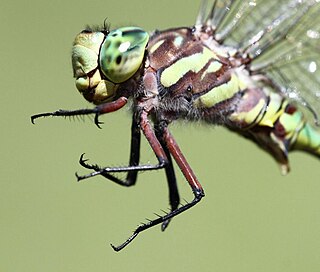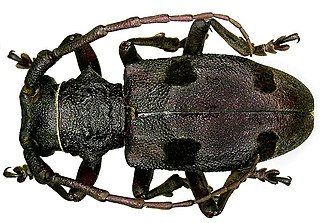
The Capparaceae, commonly known as the caper family, are a family of plants in the order Brassicales. As currently circumscribed, the family contains 33 genera and about 700 species. The largest genera are Capparis, Maerua, Boscia and Cadaba.
Parhoplophryne is a monotypic frog genus in the family Microhylidae. The sole species is Parhoplophryne usambarica, sometimes known as the Usambara black-banded frog or Amani forest frog. It is endemic to the East Usambara Mountains in Tanzania. It is only known from one specimen collected in the 1920s and is feared to be extinct.
Gulella usambarica is a species of very small air-breathing land snail, a terrestrial pulmonate gastropod mollusk in the family Streptaxidae.
Hypolysia usambarica is a species of small tropical air-breathing land snails, terrestrial pulmonate gastropod mollusks in the family Achatinidae. This species is endemic to Tanzania.
Subulina usambarica is a species of small, tropical, air-breathing land snail, a terrestrial pulmonate gastropod mollusk in the family Achatinidae.

Subulina is a genus of small tropical air-breathing land snails, terrestrial pulmonate gastropod mollusks in the family Achatinidae.

Gynacantha usambarica is a species of dragonfly in the family Aeshnidae. It is found in Kenya, Malawi, Mozambique, South Africa, Tanzania, and Zimbabwe. Its natural habitats are subtropical or tropical moist lowland forests and shrub-dominated wetlands.
Stixaceae is a family in the plant order Brassicales. It is no longer recognised by most taxonomists. The three genera formerly included in Stixaceae — Forchhammeria, Stixis and Tirania — have sometimes been placed instead in the Capparaceae, but it is now clear that they do not belong there. It is unknown where they do belong though, so currently they are unplaced at family rank. In the APG IV system, the genera comprising Stixaceae are included in the family Resedaceae.

Pinheyschna subpupillata, the stream hawker, is a species of dragonfly in the family Aeshnidae.

Phrissomini is a tribe of longhorn beetles of the subfamily Lamiinae. It was described by Thomson in 1860.
Stixis is a genus of longhorn beetles of the subfamily Lamiinae,
Zosteraeschna is the scientific name of a genus of dragonflies from the family Aeshnidae. These relatively large dragonflies are also known as hawkers. They are dark brown with yellow-green markings; On the abdomens of the males, much of the top of S2 and base of S3 are blue.
Stixis is the scientific name of two genera of organisms and may refer to:
Stixis grossepunctata is a species of beetle in the family Cerambycidae. It was described by Stephan von Breuning in 1942.
Stixis itzingeri is a species of beetle in the family Cerambycidae. It was described by Stephan von Breuning in 1936.
Prosopocera usambarica is a species of beetle in the family Cerambycidae. It was described by Stephan von Breuning in 1954.
Stixis is a South-East Asian genus of plants in the order Brassicales; they are typically lianas. This genus has previously been placed in the Stixaceae and Capparaceae, but under the APG IV system is now included in the family Resedaceae.
Stixis scandens is a species of liana in the family Resedaceae and the type species in its genus. No subspecies are listed in the Catalogue of Life. It is found in Indo-China; in Vietnam it may be called quã dây leo.

Stixis suaveolens is a species of liana in the family Resedaceae; no subspecies are listed in the Catalogue of Life. It is found in India, southern China and Indo-China; in Vietnam it may be called cây tôn nấm.
Stixis obtusifolia is a shrub or liana in the Resedaceae family. It is found in parts of Southeast Asia. The wood is used as fuel, the leaves as a tea.





